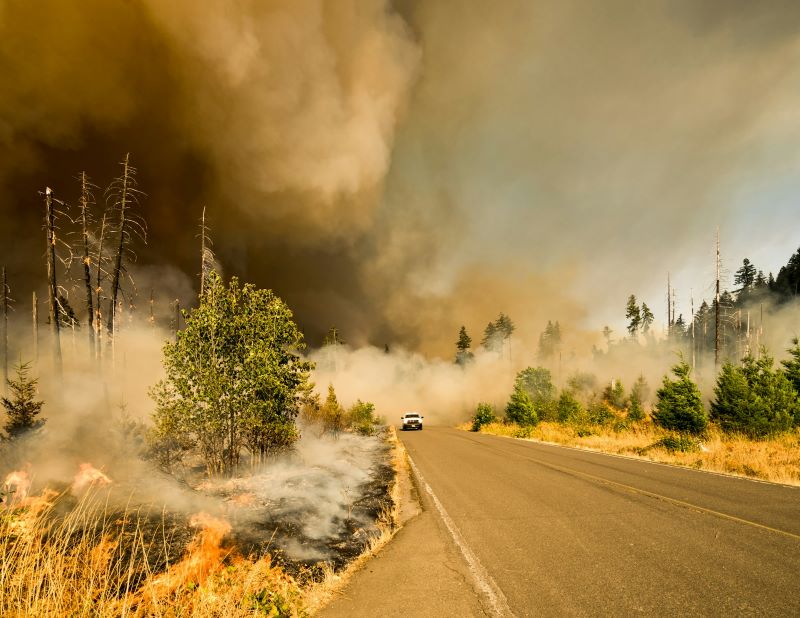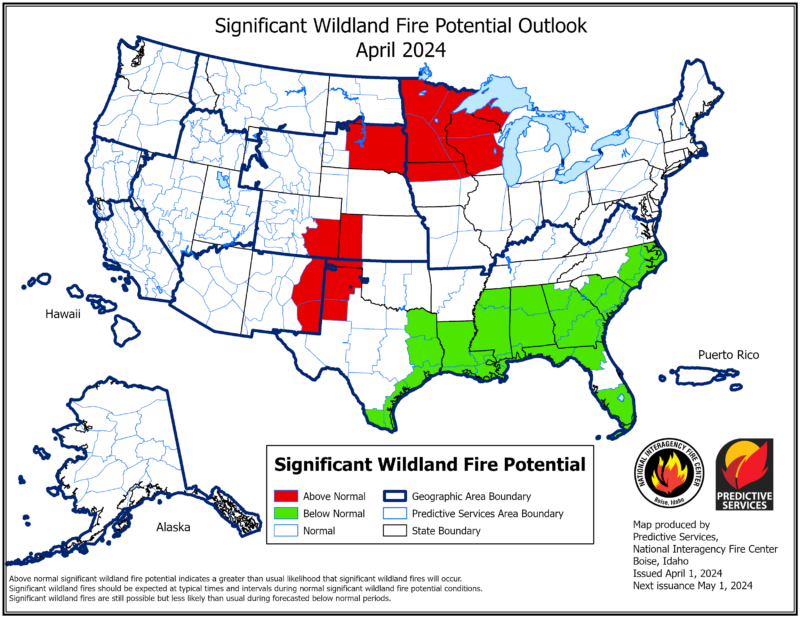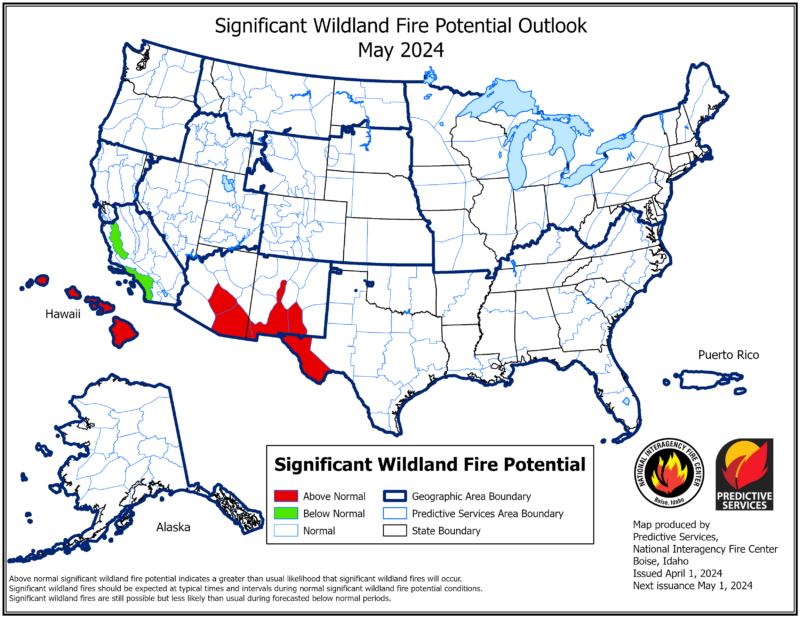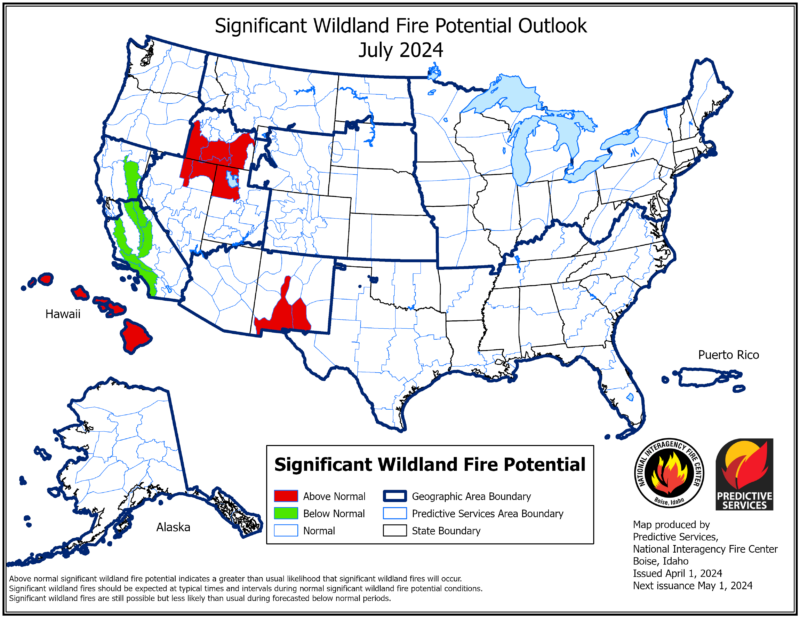
Wildfire season forecast
The National Interagency Fire Center (NIFC) has released its wildfire season outlook for April to July, 2024. NIFC is a group of wildland fire experts from eight federal agencies. It releases updated fire outlooks at the beginning of each month. According to the April to July forecast, wildfire season should get off to a slow start. For example, wet conditions in California means areas of that state should have below-normal fire potential. Meanwhile, other areas, including the U.S. Southwest, Hawaii, the upper U.S. Midwest, parts of the Great Plains and Great Basin region, have above-normal potential for wildfires in April to July, 2024.
The four-month outlook shows fire activity peaking during different months, for different parts of the U.S. Much of the U.S. had a wet winter. We’ve been in El Niño conditions, but meteorologists predict an upcoming shift to La Niña, which adds more uncertainty to the picture.
The NIFC’s forecast relates to significant fires. Therefore, the forecasts help fire managers determine where they might need to put their resources.
How is the outlook made?
According to the American Geophysical Union’s publication Eos:
The outlook is made using long-term forecasts from NOAA’s Climate Prediction Center, current precipitation and drought conditions, and an assessment of the types and moisture conditions of fuels (such as grasses, brush, and timber) available in different regions.
Wildfire season forecast for specific states
California has seen devastating wildfires in recent years, including more than 4 million acres (16,200 square km) burned in 2020. And back in 2018, the Camp Fire was the deadliest in California’s history, killing 85 as a firestorm swept through the town of Paradise. But over the past couple of years, substantial winter snows in California have built up a snowpack that experts say will protect the state through at least July. Craig Clements, a wildfire meteorologist at San José State University, said:
It’s the best-case scenario for California’s wildfire season.
However, the upper Midwest had little snow this winter with warmer conditions, meaning an elevated fire risk for April. Already this year in Wisconsin, there have been 342 wildfires, and 165 in Minnesota. But spring rains should help decrease that risk as the year goes on.
As summer approaches, the threat of wildfire shifts to the Southwest and Great Basin regions. Jim Wallman, a meteorologist for NIFC said the forecast calls for:
… an above-average risk of significant fires in southeast Arizona, southern New Mexico, southern Idaho, northeast Nevada, and northwest Utah starting in late May and continuing through July.
And, unfortunately, Hawaii is again at risk this summer. Last August, an inferno tore across the town of Lahaina on Maui, killing at least 101 people.
Read more on how to protect yourself in This Is Wildfire: Tips on preparing yourself and your home.
Wildfire maps for April through July




Prescribed burns
Often in the spring you’ll see the smoke from prescribed burns billowing into the sky. Prescribed burns are a way to limit the damage that wildfires can do by taking away their fuel. However, with the wetter winter in many locations, that fuel can’t be burned yet. So even though the wet winters help protect from wildfire, they can also make fire management more difficult in other ways.
What about La Niña?
The forecast, of course, is always liable to change. Many things can alter the predictions, such as a storm system moves in and dumps a lot of rain, or, conversely, a lightning strike that sparks a fire. But one of the big uncertainties is the coming La Niña. How soon La Niña arrives can have a big impact on the wildfire forecast. In the past, a quick onset of La Niña brought a cooler and wetter summer. But whether it arrives quickly or if it follows the same pattern as before remains to be seen. Clements said:
A rapid transition to La Niña could also create dry summer conditions in Southern California, the Southwest, and the Great Plains. La Niña could also cause a later start to typical fall precipitation in California, which could allow summer fires to persist longer than usual. But it’s still too early to make confident predictions for late summer and fall.
Wallmann said:
We’re just going to have to see exactly how this plays out.
Bottom line: The wildfire season forecast is out. Learn what regions have a higher risk and which ones have a lower risk for April to July 2024.











